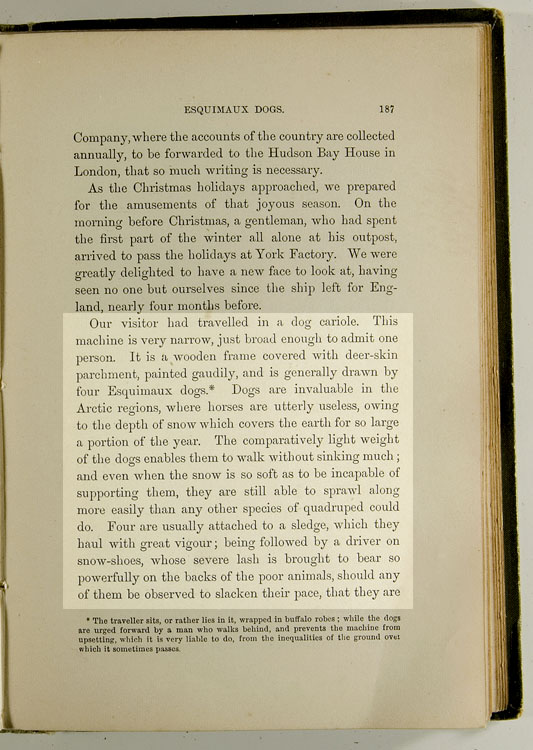
|
|
| Author: |
Robert Michael Ballantyne |
| Copyright Holder: |
Expired; no restrictions on use. |
|
|
|
Robert Michael Ballantyne (1825-1894) joined the HBC as an apprentice clerk in 1841 at the age of 16. During his six years in the fur trade, he served at Upper Fort Garry, Norway House, York Factory, and Tadoussac.
Here, he describes a dog cariole, or dog sled. Dogs were important beasts of burden and means of transportation not only in "the Arctic regions" (as Ballantyne observes) but also in the boreal forest and woodlands farther south. p187, 2nd pgh: “Our visitor… Esquimaux dogs.”
“Our visitor had travelled in a dog cariole. This machine is very narrow, just broad enough to admit one person. It is a wooden frame covered with deer-skin parchment, painted gaudily, and is generally drawn by four Esquimaux dogs.*
Dogs are invaluable in the Arctic regions, where horses are utterly useless, owing to the depth of snow which covers the earth for so large a portion of the year.
The comparatively light weight of the dogs enables them to walk without sinking much; and even when the snow is so soft as to be incapable of supporting them, they are still able to sprawl along more easily than any other species of quadruped could do.
Four are usually attached to a sledge, which they haul with great vigour; being followed by a driver on snow-shoes, whose severe lash is brought to bear so powerfully on the backs of the poor animals, should any of them be observed to slacken their pace, that they are continually regarding him with deprecatory glances as they run along.
Should the lash give a flourish, there is generally a short yelp from the pack; and should it descend amongst them with a vigorous crack, the vociferous yelling that results is perfectly terrific.
These drivers are sometimes very cruel; and when a pack of dogs have had a fight, and got their traces hopelessly ravelled (as is often the case), they have been known to fall on their knees in their passion, seize one of the poor dogs by the nose with their teeth, and almost bite it off.
Dogs are used for dragging carioles, which vehicles are used by gentlemen in the Company's service who are either too old or too lazy to walk on snow-shoes.
The cariole is in form not unlike a slipper bath, both in shape and size. It is lined with buffalo robes, in the midst of a bundle of which the occupant reclines luxuriously, while the dogs drag him slowly through the soft snow, and among the trees and bushes of the forest; or scamper with him over the hard-beaten surface of a lake or river; while the machine is prevented from capsizing by a voyageur who walks behind on snow-shoes, holding on to a line attached to the back part of the cariole.
The weather during winter is so cold that it is often a matter of the greatest difficulty for the traveller to keep his toes from freezing, despite the buffalo robes; and sometimes, when the dogs start fresh in the morning, with a good breakfast, a bright, clear, frosty day, and a long expanse of comparatively open country before them, where the snow from exposure has become quite hard, away they go with a loud yelp, upsetting the driver in the bolt, who rises to heap undeserved and very improper epithets upon the poor brutes, who, careering over the ground at the rate of eleven miles
an hour, swing the miserable cariole over the snow, tear it through the bushes, bang it first on one side, then on the other, against stumps and trees, yelling all the while, partly with frantic glee at the thought of having bolted, and partly with fearful anticipation of the tremendous welting that is to come; until at last the cariole gets jammed hard and fast among the trees of the forest, or plunges down a steep bank of a river head over heels till they reach the foot - a horrible and struggling compound of dogs, traveller, traces, parchment, buffalo robes, blankets, and snow!"
Other
Related Material
Read excerpts from Robert's writings - enter 'Ballantyne' in the search box to your left.
What did Robert Ballantyne look like?
Which HBC calendar painting includes Robert Ballantyne?
What does a cariole look like?
Check the Beaver Index - e.g., type in sledding, cariole, dogs, Ballantyne, etc.
|
Did
You Know?
Ballantyne wrote 74 books of juvenile literature (including more than 20 dealing with the Prairies, the Rockies, or the Arctic) and illustrated many of them himself.
|
|